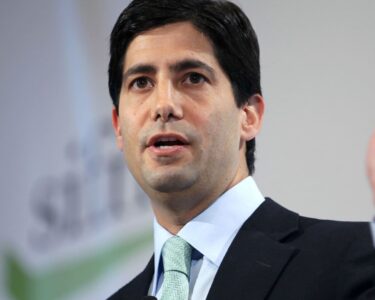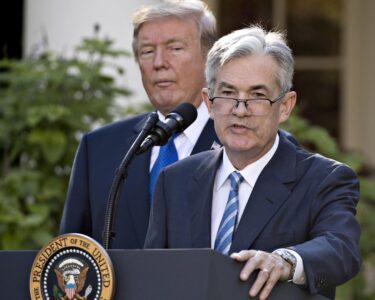Markets seem to have taken this week’s positive economic data as the all-clear signal for the Federal Reserve to start cutting interest rates aggressively next year.
Indications that both consumer and wholesale inflation rates have eased considerably from their mid-2022 peaks sent traders into a frenzy, with the most recent indications on the CME Group’s FedWatch gauge pointing to a full percentage point of cuts by the end of 2024.
That may be at least a tad optimistic, particularly considering the cautious approach central bank officials have taken during their campaign to bring down prices.
“The case isn’t conclusively made yet,” said Lou Crandall, chief economist at Wrightson ICAP. “We’re making progress in that direction, but we haven’t gotten to the point where they’re going to say that the risk of leveling out at a level too far above target has gone away.”
This week has featured two important Labor Department reports, one showing that consumer prices in aggregate were unchanged in October, while another indicated that wholesale prices actually declined half a percent last month.
While the 12-month reading of the producer price index sank to 1.3%, the consumer price index was still at 3.2%. Core CPI also is still running at a 12-month rate of 4%. Moreover, the Atlanta Fed’s measure of “sticky” prices that don’t change as often as items such as gas, groceries and vehicle prices, showed inflation still climbing at a 4.9% yearly clip.
“We’re getting closer,” Crandall said. “The data we’ve gotten this week are consistent with what you would want to see as you move in that direction. But we haven’t reached the destination yet.”
The Fed’s “destination” is a place where inflation isn’t necessarily at its 2% annual goal but is showing “convincing” progress that it’s getting there.
“What we decided to do is maintain a policy rate and await further data. We want to see convincing evidence, really, that we have reached the appropriate level,” Fed Chair Jerome Powell said at his post-meeting news conference in September.
While Fed officials haven’t indicated how many months in a row it will take of easing inflation data to reach that conclusion, 12-month core CPI has fallen each month since April. The Fed prefers core inflation measures as a better gauge of long-run inflation trends.
Traders appear to have more certainty than Fed officials at this point.
Futures pricing Wednesday indicated no chance of additional hikes this cycle and the first quarter percentage point cut coming in May, followed by another in July, and likely two more before the end of 2024, according to the CME Group’s gauge of pricing in the fed funds futures market.
If correct, that would take the benchmark rate down to a target range of 4.25%-4.5% and would be twice as aggressive as the pace Fed officials penciled in back in September.
Markets, then, will watch with extra fervor how officials react at their next policy meeting on Dec. 12-13. In addition to a rate call, the meeting will see officials make quarterly updates to their “dot plot” of rate expectations, as well as forecasts for gross domestic product, unemployment and inflation.
But pricing of Fed actions can be volatile, and there are two more inflation reports ahead before that meeting. Wall Street could find it self disappointed in how the Fed views the near-term policy course.
“They’re not going to want to signal that now is the time to start talking about decreases in interest rates, even if fed funds futures already has that incorporated,” former Boston Fed President Eric Rosengren said Wednesday on CNBC’s “Squawk Box.”
Market enthusiasm this week was built on two basic supports: the belief that the Fed could start cutting rates soon, and the notion that the central bank could achieve its vaunted “soft landing” for the economy.
However, the two points are hard to square, considering that such aggressive easing of monetary policy historically has only accompanied downturns in the economy. Fed officials also seem reticent to get too dovish, with Chicago Fed President Austan Goolsbee saying Tuesday that he sees “a way to go” before reaching the inflation target even as he holds open a possible “golden path” to avoiding a recession.
“A slower economy rather than a recession is the most likely outcome,” Rosengren said. “But I would say there’s certainly downside risks.”
The stock market rally plus the recent drop in Treasury yields also pose another challenge for a Fed looking to tighten financial conditions.
“Financial conditions have eased considerably as markets project the end of Fed rate hikes, perhaps not the perfect underpinning for a Fed that professes to keeping rates higher for longer,” said Quincy Krosby, chief global strategist at LPL Financial.
Indeed, the higher-for-longer mantra has been a cornerstone of recent Fed communication, even from those members who have said they are against additional hikes.
It’s part of a broader feeling at the central bank that it doesn’t want to repeat the mistakes of the past by quitting the inflation fight as soon as the economy shows any signs of wobbling, as it has done lately. Consumer spending, for instance, fell in October for the first time since March.
For Fed officials, it adds up to a difficult calculus in which officials are loathe to express overconfidence that the final mile is within sight.
“Part of the problem the Fed always has to deal with is this illusion of control,” said Crandall, the economist who started at Wrightson ICAP in 1982. “They can influence things, but they can’t control them. There are just too many exogenous factors feeding into the complex dynamics of the modern global economy. So I’m moderately optimistic [the Fed can achieve its inflation goals]. That’s a little different than being confident.”






